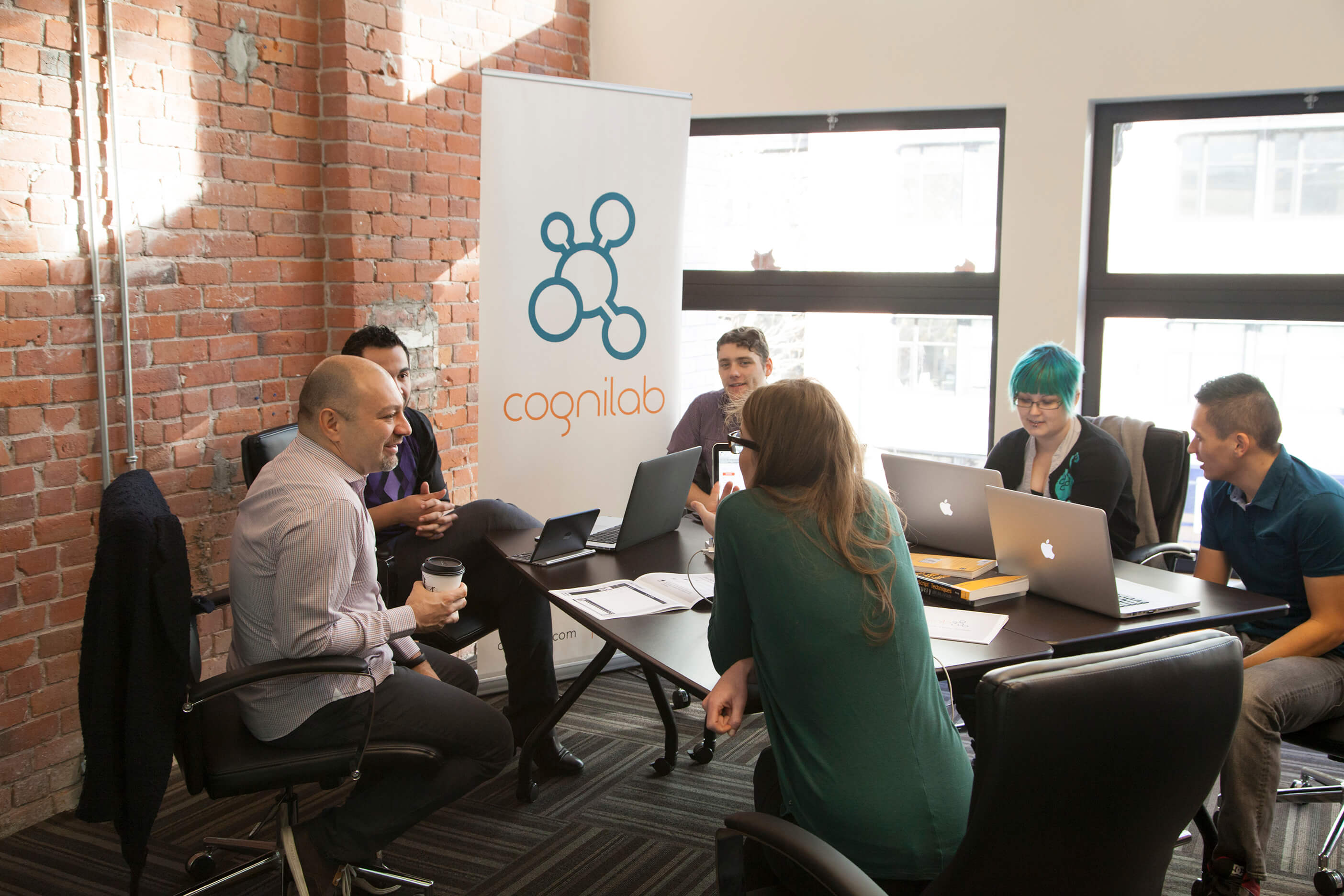This research project springs from fundamental questions of orientation facing the Social and Interactive Media (SIM) Centre at Emily Carr University in terms of industry partnerships: What is the nature of partnered research now, especially as it pertains to art, design and digital media? What does partnered research look like in the framework of startups and contemporary digital cultures, and how are evolutions in cultural and organizational models such as incubators, co-working spaces and accelerators presenting new challenges and opportunities for how partnered research is structured?
Contemporary business culture in 2014 is deeply invested with the form of the accelerator. Accelerators are organizations that support early stage companies looking to grow. In Canada there are hundreds of accelerators that mentor and launch hundreds of thousands of companies annually. One of the most prominent in Canada is Vancouver-based GrowLab.
Working primarily in the internet space, GrowLab accepts five companies three times a year into their program. Early stage teams receive seed funding of up to $175,000, office space for six months, and mentorship from top venture capitalists and a network of investors and partners. These early stage companies are often composed of teams of three to five people whose primary expertise is in technology and business. What they are typically lacking, whether on founding teams or as early employees, are designers.
With these conditions as a background, Kate Armstrong, SIM Director, engaged Haig Armen, Assistant Professor of Design and Dynamic Media, as Lead Faculty on a pilot project to forge a new research partnership with GrowLab.
Funded by an Applied Research and Development grant from the Natural Sciences and Engineering Research Council, the pilot launched in September 2013 and ran the 13 weeks of the Fall semester. Five students engaged with five companies who were either in residence at GrowLab or who had just completed the GrowLab program.
As we weighed the pros and cons of various structures to support students within the context of these real-world businesses we considered two primary models. On one hand is the model of the design studio, lab or consultancy, where a designer is engaged by a client. On the other hand is a designer embedded into a company, working alongside the rest of the company team, who is a key part of determining the direction of problem definition as well as problem solutions.
An exciting part of this partnership for us was the opportunity to engage with the culture of GrowLab and to understand how startups are distinct from other industry settings. The aim was to test not only the structure of the accelerator but the role of design and designers in it. Recognizing that the designers — 3rd and 4th year students — were often direct contemporaries of the company leads, that they would be joining small teams, and that a key part of their learning in this context would be entrepreneurial, we wanted the students to join company teams. We were also aware, however, that the students were generally inexperienced with the framework of business and that they would require support. As such, we developed a hybrid approach blending the two models. On the level of student learning we decided to frame the project around Lean UX, an approach that combines user-centric experience design methods with agile software development.
The internet has allowed software to evolve into having shorter release cycles, as it is unconfined to physical manufacturing or distribution. A technology startup generally provides a tool or service that is accessed through the internet where the software can be updated and refined in a continuous, ongoing manner. Agile development methodology focuses on the early and continuous delivery of software, allowing changes at any stage in the process.
One of the facets of agile processes that has become an integral part of startup culture is how the internet allows for testing to become a pivotal part of identifying product-market fit.
As Jeff Gothelf writes in Lean UX, “teams are pushing new code to production as fast as you can save a Photoshop file. And they are using these short cycles as a competitive advantage — releasing early and often, gaining market feedback, and iterating based on what they learn.” [1]
With startups predominantly following agile methodologies, older models of workflow in which a designer delivers a finalized approach to a developer to implement are not workable.
As a solution, the Lean UX approach recombines parts of the designer’s tool kit in a way that adapts to an agile framework. Lean UX suggests a continuous design engagement that requires designers to strip away heavy deliverables in favor of techniques that allow them to build shared understandings with teammates. A designer then becomes an integral part of the quick iterative cycle of Hypothesis > Implementation > Observation > Repeat. Using market feedback, design conversations are reframed in terms of objective business goals. Designers measure what works, learn from it, and adjust.
On the internet, design is written in and through all aspects of a product.
The relevance of the designer in this model is notable. On the internet, design is written in and through all aspects of a product. The designer actively co-creates the work on every level including on the level of ideas. Because of the centrality of user experience to the product, designers often become the product people on a team. When the startup’s core value is delivered through the web (via a web service or app), the designer’s role is not only to communicate the value of the startup’s offering, but also to effectively redesign the product.
The five research assistants in this project were Zoe Hardisty, Claire Carsley, Bob Ross, Rongxin Zhang, and Brenna Randlett. Three came from an interaction design background, one from a communications design background, and one from industrial design. One was in 4th year, three were in 3rd year, and one was from Continuing Studies.

The five companies were: Cognilab, a platform for creating and participating in research studies; Farm at Hand, which provides a cloud-based software platform for farm management data; Spacelist, which facilitates finding and marketing office, retail and industrial space for rent; Retsly, an API for developers to create mobile apps for the real estate market, and Callings (previously Karmahire), which helps students and employers start a conversation via an online job fair.
Insights
Models and Efficiencies for Partnered Research
One of our aims with this project was to develop a new structure for working with the unique configuration of an accelerator, versus, for example, making individual arrangements with a group of startups unaffiliated with an accelerator community.
Engaging on this level with an accelerator resulted in an efficiency for us: We can reach five companies through one partnership. It is also a future-facing structure for partnership, allowing for continuation as the accelerator continues to accept new cohort companies. Based on five companies per GrowLab intake and three intakes per year, we are theoretically able to reach fifteen companies in a year. Administratively, this is a significant shift that increases the scope of partnership activity
Additionally there is the screening or evaluation of potential partner companies. In locating new partners for university research, there is the challenge of evaluating their likelihood of success as a company, the impact the company might have culturally or economically, and their character. In this model, the vetting process performed by GrowLab when choosing companies acts as a filter. To provide perspective, GrowLab accepts five companies per cohort from an average of 400 applications. It is not necessarily within the realm of a university research department to assess the quality of a business case offered by a prospective partner in research. Yet, it is very important, as it affects the impact of the product, the fit for the student, and reflects on the school when measured in terms of the university’s research mandate of cultural and intellectual relevance.
Silos
We learned during the course of this project that the areas of program specialization that are key structures within the university — such as industrial design, communication design and interaction design — had little effect within the companies. From a disciplinary perspective, these researchers were three interaction designers (two full time and one continuing studies), a communication designer and an industrial designer. All researchers were equally able to contribute their core skills, predicated around design thinking, and have equal impact and value on their teams, despite the fact that the GrowLab companies operate in the interaction-heavy context of technology. What the designers had in common was a certain level of proficiency with coding HTML/CSS. We can reflect that digital proficiency in front-end coding should not be seen within the curriculum as a vertical distinct from other design disciplines, but rather should be treated as an approach across all disciplines which, like media, informs and affects most aspects of life in contemporary culture.
We found ourselves working in the spaces between; between the student and the startup, between the university and the industry, between the accelerator and the individual company, between our research and the applied work of the company.
This feeling of being “in between” relates at least in part to the ambiguity of what design research actually means in the current frame of industry. The framework of agile development in these companies means that there is no true split between “research” and “development”. Research and development are both part of a continual process of iteration and production. Products are designed and built, tested, redesigned, rebuilt and tested again. Startups create software to learn what is possible and how it might be received. It is an accelerated process with no beginning or end, and with few formal phases; discovery is integrated throughout the entire project timeline.
This approach is distinct from other industries where more pronounced divisions between research, design and development may be in place. In this environment, either research and development are one and the same, or there is no research, only development. The very act of implementation and user testing becomes the research.
To learn more about the explicit role of research in the cultures and operations of the five individual companies, we performed exit interviews at the conclusion of the pilot. Asked what the word “research” means to their specific everyday operations of their companies, most reflect that, as a term, it is broadly irrelevant. And yet research itself is so relevant to these teams that companies will pivot their entire product or market in a weekend if testing reveals imperfect market fit or slow user uptake. The applied context of this design research was so relevant that 100% of Emily Carr researchers were offered positions at their host companies at the end of the pilot.



